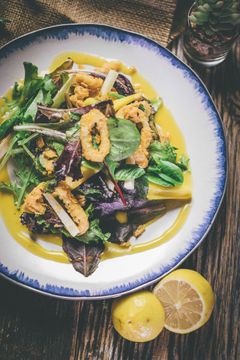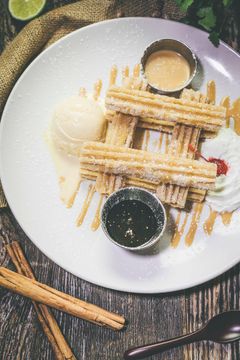Treat yourself to churros that are freshly made and irresistible
Wiki Article
What Are the Essential Dishes That Specify Mexican Food?
Mexican cuisine is a lively representation of its social heritage, characterized by a selection of crucial meals. Tacos, mole, pozole, tamales, and ceviche each tell an unique tale of tradition and taste. These foods not just please the palate but likewise personify the spirit of neighborhood and party. Understanding their value exposes much concerning Mexico's culinary identity. What lies below the surface area of these precious dishes?
Tacos: The Quintessential Road Food
Tacos are frequently considered as the perfect street food of Mexico, celebrated for their convenience and rich flavors. They include a basic tortilla, typically made from corn or flour, full of a range of components that can range from smoked meats to veggies. This adaptability allows for plenty of regional variations, each showcasing neighborhood flavors and practices.Popular fillings consist of carne asada, carnitas, and pollo, frequently come with by fresh garnishes like cilantro, onions, and lime. Road suppliers expertly prepare and serve tacos, making them a hassle-free and inexpensive choice for visitors and locals alike.
The experience of eating tacos is improved by the lively environment of Mexican streets, where the fragrance of seasonings and crackling meat loads the air. This iconic recipe not just pleases hunger but additionally stands for the cultural richness of Mexico, showing its history, neighborhood, and cooking virtuosity.
Mole: A Harmony of Flavors
Mole personifies the complexity and depth of Mexican food, providing a rich tapestry of tastes that mesmerize the palate. This sauce, usually made with a mix of chilies, flavors, nuts, and chocolate, showcases the creativity and cultural heritage of Mexico. Each region boasts its special interpretation, with variants such as mole poblano and mole negro, mirroring local ingredients and traditions.The preparation of mole is a detailed process, requiring skill and persistence as the components are meticulously toasted, ground, and simmered to perfection. The resulting sauce can vary from full-flavored to pleasant, with layers of taste that develop with each bite. Traditionally served over hen or turkey, mole transcends mere nourishment, usually gracing special events and events. Its vivid color and facility profile represent the rich culinary identity of Mexico, making it an essential dish that reverberates with both visitors and residents alike.
Pozole: A Hearty Practice
Although frequently delighted in during cheery events, pozole is a dish deeply rooted in Mexican custom, personifying both social importance and communal spirit. This hearty soup, made mostly from hominy, meat-- normally pork or hen-- and a rich broth, has ancient origins that trace back to pre-Columbian worlds. Typically gotten ready for celebrations such as Mexican Freedom Day and weddings, pozole goes beyond plain sustenance, fostering a sense of unity amongst those that take part.The meal can be found in numerous local variations, consisting of pozole rojo, blanco, and verde, each differentiated by Homepage its unique ingredients and flavor accounts. Garnishes such as shredded cabbage, radishes, avocado, and lime improve the dish, enabling personal expression. Beyond its see post delicious high qualities, pozole serves as a symbol of heritage, attaching generations via shared dishes and cooking methods. Its preparation commonly comes to be a public occasion, enhancing bonds among household and friends, making it a true symbol of Mexican friendliness.
Tamales: Covered crazy
Tamales hold an unique location in Mexican food, a lot like pozole, commemorating custom and neighborhood. These delightful parcels of masa, or corn dough, are generally filled up with a selection of active ingredients, including meats, fruits, veggies, or cheeses, and afterwards wrapped in corn husks or banana leaves prior to being steamed to excellence - churros. The prep work of tamales typically involves family events, where generations integrated to share the labor of blending, filling, and wrapping, strengthening their significance as a common mealTamales are especially preferred throughout joyful celebrations, such as Christmas and Día de los Muertos, signifying a link to social heritage. They are not just food; they personify love, care, and the passing down of cooking skills. Each area in Mexico boasts its own one-of-a-kind variations, showcasing regional tastes and practices, making tamales a beloved staple that goes beyond generations and joins people throughout the nation.
Ceviche: A Fresh Coastal Delight
Ceviche, a vibrant meal rooted in the coastal areas of Mexico, showcases the freshness of the ocean's bounty. Traditionally made with raw fish seasoned in citrus juices, particularly lime, ceviche is celebrated for its invigorating flavor profile. The level of acidity from the lime "cooks" the fish, leading to a tender structure that sets magnificently with the intense active ingredients frequently included, such as diced tomatoes, onions, cilantro, and chili peppers.
Regions like Baja California and the Yucatán Peninsula have their own distinctive versions, including local seafood such as shrimp, octopus, or scallops. Served official source chilled, ceviche is frequently come with by tortilla chips or tostadas, enhancing its appeal as a preferred appetiser or snack. This recipe not only mirrors the abundant marine life of Mexico however also highlights the social relevance of fresh, regional components in Mexican gastronomy. Ceviche remains a precious depiction of coastal culinary customs.
Frequently Asked Inquiries
What Are the Key Active Ingredients in Standard Mexican Cuisine?
Key active ingredients in traditional Mexican cuisine include corn, beans, chilies, tomatoes, and avocados. mexican food. These staples develop the foundation of numerous dishes, mirroring the vivid flavors and varied cooking heritage of Mexico's abundant gastronomic landscapeHow Has Mexican Food Developed Over Time?
Mexican cuisine has actually progressed through centuries, affected by indigenous practices, Spanish emigration, and worldwide ingredients. This dynamic mix has actually led to varied local flavors, methods, and meals that remain to innovate and adapt with modern culinary fads.
What Prevail Dietary Restrictions in Mexican Food Preparation?
Usual nutritional restrictions in Mexican food preparation include gluten, vegetarianism, and veganism intolerance. Numerous conventional meals can be adjusted to accommodate these choices, guaranteeing that flavors continue to be vibrant while valuing private nutritional requirements and social practices.Exactly How Do Regional Variations Influence Mexican Meals?
Regional variations substantially influence Mexican meals with regional components, traditional cooking techniques, and social impacts. Each region's one-of-a-kind environment and history add distinctive tastes, strategies, and recipes, leading to an abundant culinary variety across the country.What Beverages Pair Best With Mexican Food?
Standard Mexican food sets well with drinks like horchata, aguas frescas, and tequila. Craft beers and mezcal likewise enhance the tastes, improving the eating experience with their stimulating attributes and unique accounts.Mexican cuisine is a lively reflection of its cultural heritage, characterized by a range of essential recipes. Mole personifies the complexity and depth of Mexican cuisine, offering a rich tapestry of tastes that mesmerize the palate. Typically delighted in during cheery events, pozole is a dish deeply rooted in Mexican practice, embodying both social importance and public spirit. Mexican food has actually developed via centuries, affected by aboriginal practices, Spanish emigration, and international active ingredients. Regional variations considerably affect Mexican recipes via neighborhood ingredients, standard food preparation techniques, and social impacts.
Report this wiki page